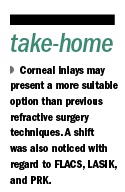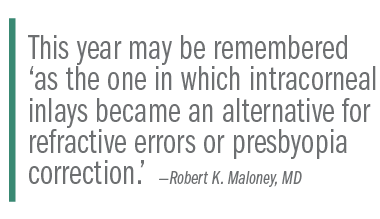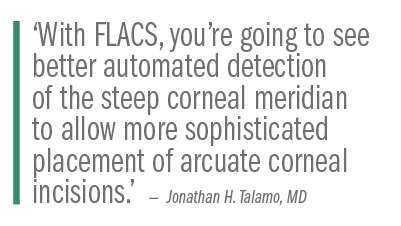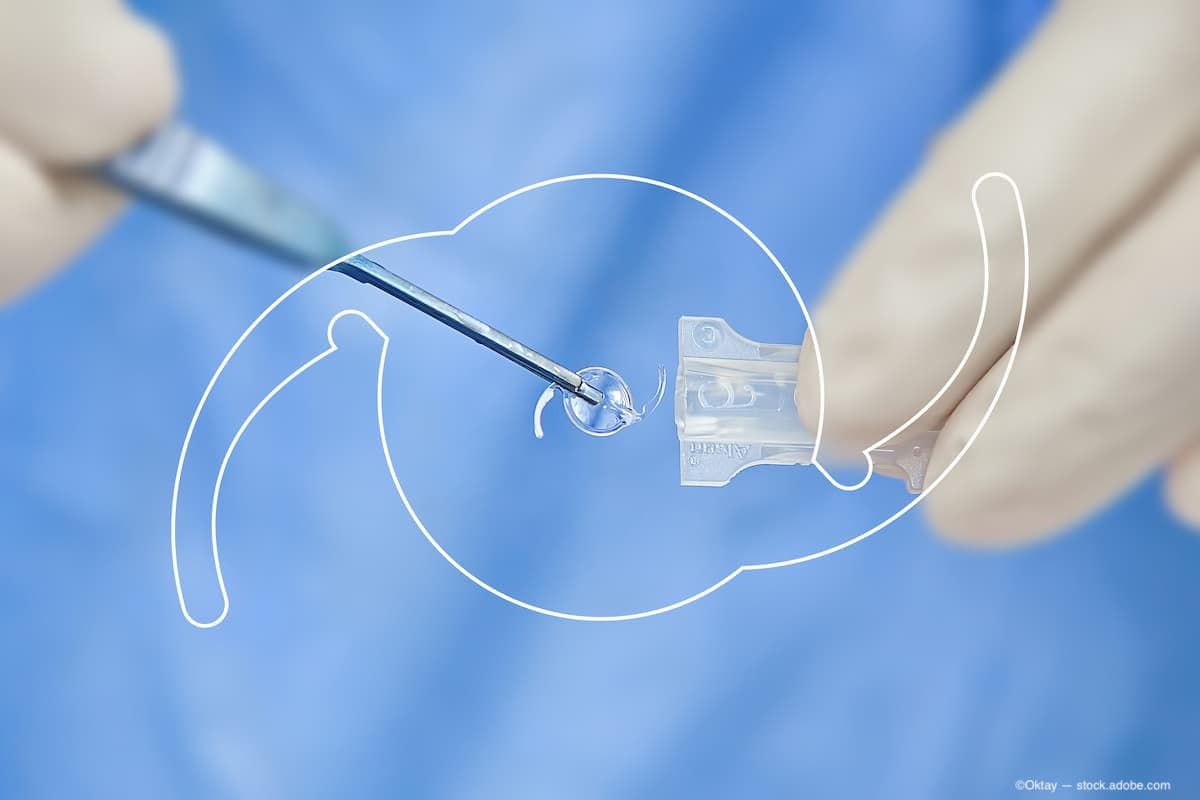Article
Was 2015 the year of inlays, FLACS, or something else?
While 2015 may not have been the year for ground-breaking introductions or trials in the field of refractive surgery, plenty of improvements have kept the procedure an evolving process, Ophthalmology Times editorial advisory board members said.
Reviewed by Peter S. Hersh, MD, Robert K. Maloney, MD, and Jonathan H. Talamo, MD
While 2015 may not have been the year for ground-breaking introductions or trials in the field of refractive surgery, plenty of improvements have kept the procedure an evolving process, Ophthalmology Times editorial advisory board members said.
One of such advances was the FDA approval of a corneal inlay (KAMRA, AcuFocus ), which may be a first in a series of inlay approvals, said Robert K. Maloney, MD, of the Maloney Vision Institute, Los Angeles.
“[This] is going to be the year we remember as the one in which intracorneal inlays became an alternative for refractive errors or presbyopia correction,” he said.

Any method, device, or treatment that represents “a dependable and efficacious treatment of presbyopia is of tremendous interest within the field of refractive surgery,” said Peter S. Hersh, MD, of The Cornea and Laser Eye Institute-Hersh Vision Group, Teaneck, NJ, believes the U.S. approval of a corneal inlay is by far the most important occurrence in the refractive field this year.
Related: Comparing presbyopia treatment options
Dr. Maloney agreed: “I really am a believer in corneal inlays. They’re a very benign and reversible way to correct refractive errors and presbyopia. That’s the advantage they have over LASIK, particularly when you’re looking at multifocal corrections.”
Multifocal LASIK can be difficult to reverse if a patient ends up disliking their postoperative vision, and multifocal IOLs are an invasive procedure. But multifocal inlays are very easy to perform and can be removed if the patient does not like the outcomes, Dr. Maloney said.
“For a particular subset of patients, corneal inlays may be the way to go,” Dr. Hersh said. “For older patients over the age of 60-65 years, we would still be looking at lens extraction and multifocal premium lenses. But for those in the mid-range of presbyopia, the inlays will have an evolving place among the alternatives of LASIK monovision and presbyLASIK.”
Next: Outcomes of deep pocket inlays
A pocket inlay deep into the cornea has a better ultimate outcome than an inlay placed under a corneal flap, according to Dr. Hersh. “This mitigates unwanted topography changes and potential corneal melts,” he said. Dr. Hersh participated in some of the earlier clinical trials on the KAMRA, and has been performing procedures with a deep corneal pocket of usually about 240 μm.

The Raindrop Near Vision inlay (ReVision Optics) may be on the U.S. market as early as next year-the company filed for approval in the fourth quarter. Other inlays, namely the Flexivue Microlens (Presbia) and the InVue intracorneal microlens (Biovision), must go through regulatory filing before they are available in the United States.
But because they each work a little differently, there’s room in the marketplace for all of them, Dr. Maloney said. “We’re in a position where in a few years, we may have 2 to 3 different corneal inlays and each will be appropriate for different patients,” he said. “People aren’t coming into our offices asking for an inlay-they’re asking for a way to treat presbyopia.”
Practice Management: 5 key strategies to grow your practice
The VisAbility device is promoted by ReFocus Group as the first medical device designed to improve near vision that is performed in both eyes. It is also said to be the only treatment for presbyopia that can restore near and intermediate vision without compromising distance vision.
Dr. Maloney, however, remains skeptical about the device and its potential. “I doubt scleral expansion-which is what this represents-is going to be a solution for presbyopia. Various forms of scleral expansion have been around for 15-20 years, and they just don’t show significant improvements in near vision,” he said.
While the technology and technique involved in corneal onlays have been around since the early 1990s, they have a long way to go before they will be ready for commercialization, Dr. Maloney said.
Next: SMILE and FLACS
SMILE
The small incision lenticule extraction (SMILE) procedure is designed to address all refractive errors and involves a femtosecond laser to create a corneal lenticule that is then removed through a small incision without the use of a laser.
Ernest W. Kornmehl, MD, of Kornmehl Laser Eye Associates Brookline, MA, agrees the SMILE procedure is an advancing procedure.“Multiple studies now have shown that it does induce less dry eye. SMILE tends to be more stable than LASIK, and appears to be useful in lower myopes, but it also has certain drawbacks,” he said.
With no U.S. studies under way on the procedure, “that’s very telling,” he said.
Related: Refractive surgery for special needs children
FLACS
The year may be regarded as one where femtosecond laser for cataract refractive surgery (FLACS) became more mainstream, specialists said.
“With FLACS, you’re going to see better automated detection of the steep corneal meridian to allow more sophisticated placement of arcuate corneal incisions,” said Jonathan H. Talamo, MD, of Mass. Eye and Ear, Boston. “You’re going to see more traction for the technique for performing intrastromal arcuate incisions for astigmatism, which avoids some of the wound healing variability that has been an issue with the conventional incisions, so that’s a small but significant incremental tweak to refractive cataract surgery.”

With estimates suggesting almost 40% of cataract refractive surgeons are now offering image-guided laser cataract surgery (a term Dr. Talamo prefers to FLACS), “we’ve seen a tremendous evolution” since the first U.S. approval in 2009. Currently, the Catalys (AMO), LenSx (Alcon), Victus (Bausch + Lomb), and the LENSAR with Streamline (Alphaeon,) all have U.S. regulatory approval.
According to Dr. Maloney, 2015 marked the first year where using these lasers went from being an optional procedure to being the best way to do cataract surgery. “It was the year in which I decided that when I have cataract surgery, there’s no way I’m letting somebody do a manual procedure on me. I think that it represents a real change in perspective,” he said.
The LENSAR Streamline adds the capability of using a Scheimpflug imaging of the cataract, said Farrell “Toby” Tyson, MD, Cape Coral, FL. “That’s going to set it apart, because it allows us to break down different lamella and see the various densities,” he explained.
He equated the device to a peanut M&M-with the Streamline, surgeons can determine if there’s a peanut inside the density whereas the other devices only see the candy shell exterior and cannot discern whether there is solid chocolate or a peanut inside.
And because the device can save time, it inevitably increases a surgeon’s per-minute fee, even when the additional time is factored in, Dr. Tyson said.
“We’re only concentrating the laser on the areas of greatest density, so we’re putting less energy into the eye,” he said.
Next: LASIK and PRK
LASIK and PRK
Dr. Maloney considers the iDesign system (AMO) to be “the first innovation in laser surgery in a number of years.”
For Dr. Hersh, “the recent approval of topography guided LASIK (Alcon Wavelight) is an exciting innovation that we look forward to starting clinically in the United States.”
Dr. Kornmehl said this year the pendulum started swinging back toward PRK.
“In my practice, about three of every 10 patients who are candidates for LASIK request PRK. They just don’t want a flap and they don’t mind the extra discomfort for the first 24 hours,” he said.
Among the technologies in development, Dr. Hersh said exciting potential resides with the use of actual corneal tissue to form an inlay. He explained this as tissue that is obtained from corneas and prepared in the right configuration to be used in an inlay procedure to correct a variety of refractive errors. Some European studies are evaluating using inlays that have been taken from the SMILE technique, he said.
Recent news: Online vision testing stirring up controversy
For example, using the lenticule removed in SMILE as a corneal inlay for potentially treating presbyopia and hyperopia is more like an intrastromal partial thickness corneal transplant, but it is still a refractive procedure, Dr. Hersh said.
Low-add multifocal lenses also gained momentum during the year. The new low-add Tecnis lens (Abbott Medical Optics, Abbott Park, IL) completes the family of lenses, Dr. Tyson said.
“By going to the 3.25 D and the 2.75 D, AMO was able to eliminate some of the rings on the platform. That translates to a reduction in the glare and halos that are perceived by the patient, but by pushing the near focus point a little further out, it’s giving you a much better intermediate,” Dr. Tyson said, adding the defocus curve was better than 20/20 at distance.
He said patient feedback has been great as the complaint rate was only 0.7% compared to the 4% complaint rate for the Tecnis multifocal 4.0.
As these multifocal lenses continue to move toward low-adds, they’re becoming extended depth of focus lenses and are coming closer to being competitors to the crystalens accommodating lens, Dr. Tyson said.0
Peter Hersh, MD
e: phersh@vision-institute.com
Dr. Hersh has financial interest with Addition Technology, Avedro Inc., and Synergeyes.
Robert K. Maloney, MD
e: rm@maloneyvision.com
Dr. Maloney has financial interest with Abbott Medical Optics, Alcon Laboratories, Calhoun Vision, and Stromal Medical.
Jonathan Talamo, MD
e: jht@jhtmdpc.com
Dr. Talamo has financial interest with Abbott Medical Optics, Cowen and Co., CXL Ophthalmics, Intersystems, Moelis Capital, OptiMedica, Rebisan, Shire, SV Life Sciences Advisors, and WaveTec Vision.
Newsletter
Don’t miss out—get Ophthalmology Times updates on the latest clinical advancements and expert interviews, straight to your inbox.





